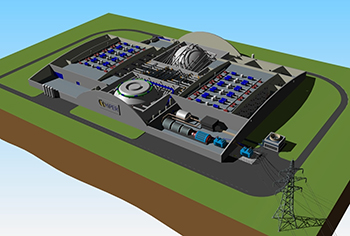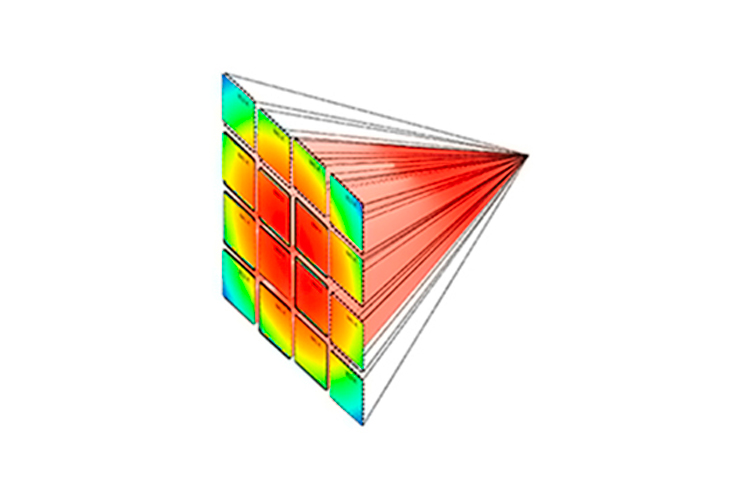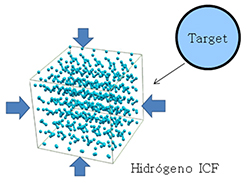Materials. Safety & Radiation Protection
Materials
The study of materials capable of operating under the severe irradiation conditions of a nuclear fusión power plant is of paramount importance for the development of the technologies necessary to generate electricity by nuclear fusion reactions. In fact, nowadays, we can find bottlenecks in several fields due to the lack of suitable materials.
The group of materials of the Instituto de Fusión Nuclear has as a mission the development, characterization, qualification and modeling of existing and new materials for applications in Nuclear Fusion. In particular, the group actively participates in the European laser fusion project HiPER, in different aspects, such as, the chamber design, materials selection, development of new materials, experimental validation of the materials, power plant technology development and computational simulation.

Power plant scheme of the European Project HiPER that aims at developing laser fusión

Element distribution maps in ODS steels obtained by the ion beam technique PIXE. These steels have application in nuclear fusion as a structural material due to their high resistance to neutron bombardment
In many cases, the studies we carry out find an application both in laser fusion and in magnetic fusion. For instance, the development of structural materials for operation under neutron irradiation is to certain extent similar in both cases.
However, in other cases, we treat specific aspects of one of the fusion approaches. For instance, the study of materials for final lenses in a laser fusion power plant presents some features absent in magnetic fusion plants, such as, the pulsed nature of the ion, neutron and X-ray irradiation or the bombardment with particle clusters (shrapnel).

Temperature profile in steady state along a lens subject to neutron bombardment. The study has been carried out by means of radiation transport codes and codes for simulation with finite element methods
The final challenge is to integrate in a realistic scheme the different materials related problems we find. The following scheme shows a section of the chamber where different elements can be visualized: a first wall to accommodate the incoming radiation, a structural steel, a helium cooled region and a liquid metal blanket for tritium breeding.

Although the studies on materials are often oriented to applications in nuclear fusion, undoubtedly, these studies are of interest for other fields. In this sense, for instance, the development carried out to build an experimental facility for studies of corrosion by liquid metals has a clear application in nuclear fusion for the study of liquid breeding blankets, and in addition, it is appropriate for studies in other fields of engineering: study of anticorrosion coatings, energy applications, collectors, turbines, generation IV reactors.
One of our strong points relies on the multiscale simulation, which we apply to different materials and experimental conditions. We carry out studies by means of finite element (FE) methods on the thermomechanical response of materials under irradiation. Studies on the evolution of irradiation-induced damage in tungsten and steel with object kinetic Monte Carlo (OKMC) methods. At an atomistic level, we carry out studies in several materials by means of molecular dynamics (MD) techniques. And finally, we apply the density functional theory (DFT) to detailed studies on complex systems such as solids under high pressures (hundreds of GPa). An example is the compression of fuel targets in laser fusion.

Schematic representation of the compression of solid hydrogen for laser fusion target applications
Safety and Radiation Protection
One of the key research issues of new coming energy era would be the environmental impact of fusion facilities managing a kilogram of tritium. The potential change of committed dose regulatory limits together with the implementation of nuclear design principles (ALARA, D-i-D) for fusion facilities could strongly impact on the cost of deployment of coming fusion technology Acute modeling of environmental tritium transport forms (HT, HTO) for the assessment of fusion facilities dosimetric impact in Accidental case and normal conditions appears as of major interest.
This paper considers different short-term releases of tritium forms (HT and HTO) to the atmosphere from a potential fusion reactor located in the Mediterranean Basin. The work model in detail the tritium forms dispersion and dosimetric impact of selected environmental patterns both inland and in-sea using real topography and forecast meteo data (ECMWF/FLEXPART).
We explore specific values of this ratio in different levels and we examine the influence of meteorological conditions in the HTO behavior for 24 hours after the release. For this purpose we have used a tool which consists on a coupled Lagrangian ECMWF/FLEXPART model and Normtri code.
